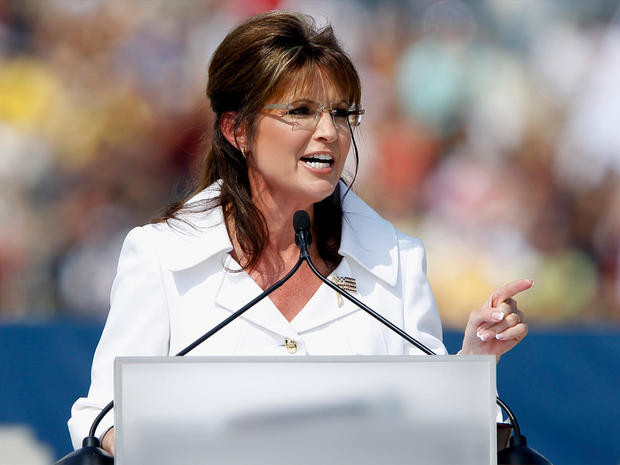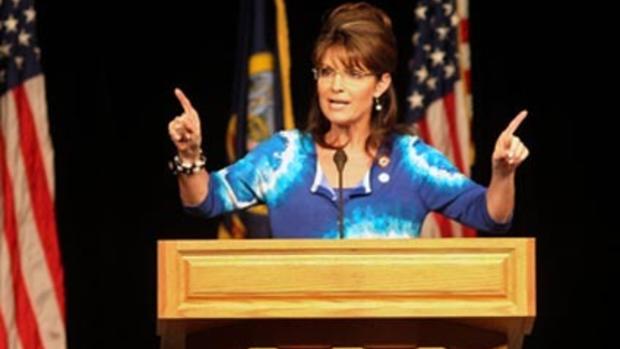What would a Palin candidacy mean for Romney?
This post originally appeared on Slate.
The Mama Grizzly is coming out of hibernation. This weekend, Sarah Palin is launching her "One Nation" bus tour, visiting historical sites across the country. Palin will start on Memorial Day at the Rolling Thunder weekend motorcycle rally that starts at the Pentagon. Where it will end has yet to be announced. But given Palin's other recent move--the announcement of a feature-length film on her tenure as governor--it looks as if her ultimate destination may be the White House.
Whatever Mitt Romney had on his plate for Memorial Day, he'd better make room. If we assume--for the purposes of page views--that Palin is getting into the race, the Republican contest immediately becomes one between Palin and Romney, with other candidates circling for a way to break into the conversation. A recent Gallup poll shows Romney (17 percent) and Palin (15 percent) essentially in a tie among Republican voters. The third-place candidate, Ron Paul, has only 10 percent support.
Sarah Palin to launch bus tour to "energize Americans"Romney, Palin lead in new GOP poll, Herman Cain not far behind
The polls are not terribly meaningful at this point, of course. Name recognition has a lot to do with these numbers, so it's not surprising Palin and Romney are at the top. What may be more meaningful in assessing the Romney vs. Palin matchup is the polling about the characteristics of the two candidates' supporters. Romney comes out ahead. Palin has more intense followers, but she also has more intense detractors, and for the last few months her momentum has been going in the wrong direction in her party.
In late April, Gallup asked Republican voters which candidate they would definitely not vote for. Palin was chosen by 37 percent. Only 26 percent said that about Romney. Among all voters, the gap is even more vast. Some 65 percent of registered voters say they would not vote for Palin; only 45 percent say they would never vote for Romney. (Obama's number is 46.)
In recent months Palin's unfavorable ratings among Republicans have gone up. In a recent Washington Post poll, 37 percent viewed her unfavorably. That was up from 24 percent last October. Romney, on the other hand, has been going in the other direction. In January 2008, in the heat of the primary fight, 36 percent viewed him unfavorably. Only 21 percent view him unfavorably now in the same Post poll of Republicans. A recent Associated Press poll mirrored those findings for Romney.
Palin also has hurdles on the question of fitness for office. Some 67 percent of the country does not think she is qualified to be president, according to a Washington Post poll from last year. Seventy percent of independent voters hold that view. Even among Republicans, 46 percent hold that view. Those findings are consistent with a Gallup poll from a year ago. In that poll, Romney was considered unqualified by 39 percent of respondents.
If the Palin vs. Romney contest takes place (and TV producers have their fingers crossed, candles lit, and talismans on), it will take place along the existing fault lines in the Republican Party: between the managers and the populists, as the National Journal's Ron Brownstein put it. The Gallup poll shows that Romney captures the support of college-educated voters, whereas Palin does better with those who have not graduated. In another poll, Romney does well with those who make more than $90,000, whereas Palin has more support among those who make less than $24,000. Romney does twice as well among older voters as Palin.
So what happens? We know what President Obama's strategists would like: a civil war between the Romney's establishment Republicans and Palin's Tea Party populists. They would like it to mirror the 1996 GOP race, in which Steve Forbes drained Bob Dole of resources, weakening him for the general election.
The view among Republican strategists involved with various current and past campaigns is that Romney benefits from Palin's entry. Romney's supporters are unlikely to leave him for Palin. Palin not only steals a portion of the anti-Romney vote from candidates like Tim Pawlenty and Jon Huntsman; she also steals available television air time. She makes it harder for second-tier candidates to get noticed.
A Palin candidacy also potentially changes the shape of the Iowa caucus, which helps Romney, who is not in a position to do well there. She appeals to the state's large number of evangelical caucus voters. If she wins or does well, Romney can argue that Iowa is following its pattern of selecting quirky, unlikely-to-win-the-nomination candidates like Mike Huckabee and Pat Robertson.
There is one scenario, however, in which Palin's entry could cause Romney's numbers to fall. Right now, the dynamic of the race is that there is Romney and an anti-Romney candidate. If it becomes instead Palin and an anti-Palin candidate, Huntsman or Pawlenty might have a moment in the sun.
It was once thought that the Republican nominating race would lack excitement. Newt Gingrich did what he could to keep things lively, but now the master has arrived. Whether Palin runs or not, she has arrived at just the moment the race appeared to be taking shape--and she has brought buses, and motorcycles, and a little bit of chaos.
More from Slate:
Is President Obama endangering Israel--or trying to save it?
Meet Rep. Joe Walsh, the biggest media hound in the freshman class.
President Obama's penchant for older judges scuttled Goodwin Liu.


